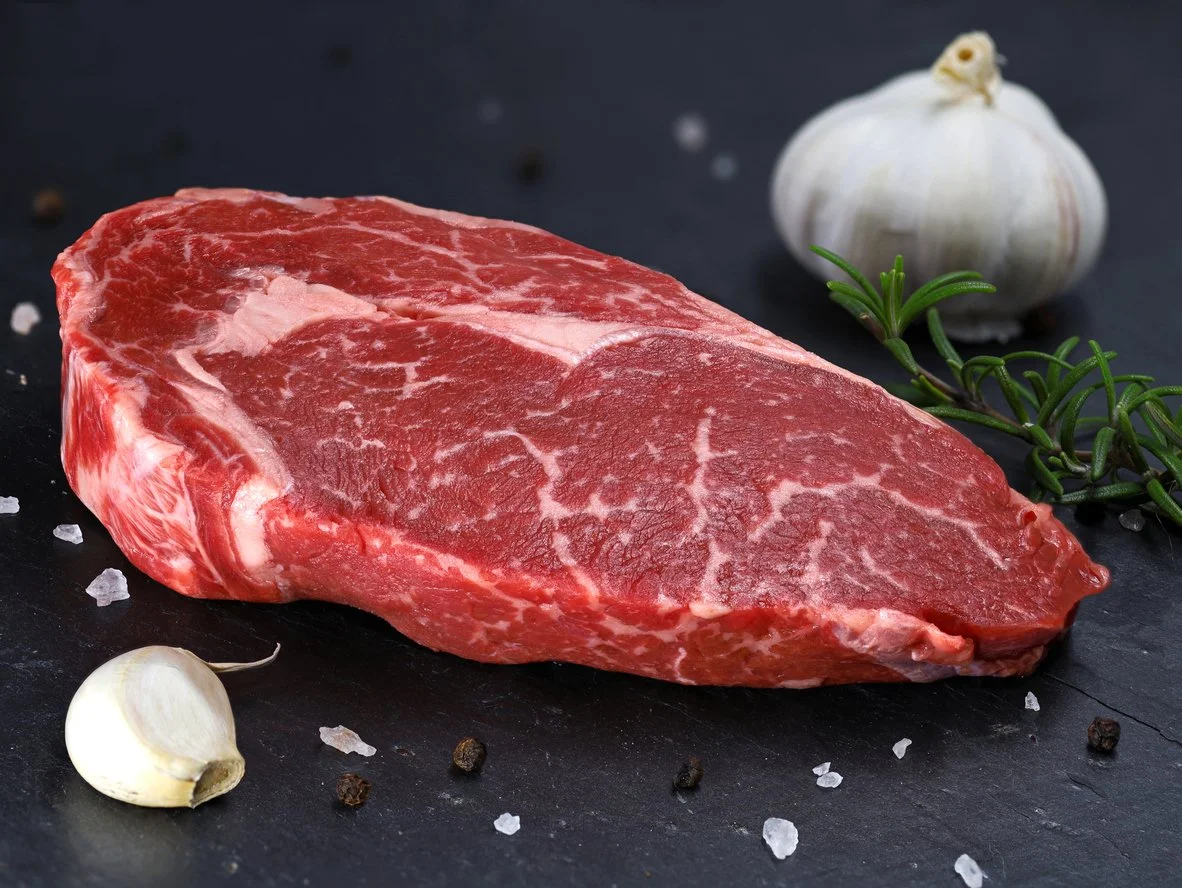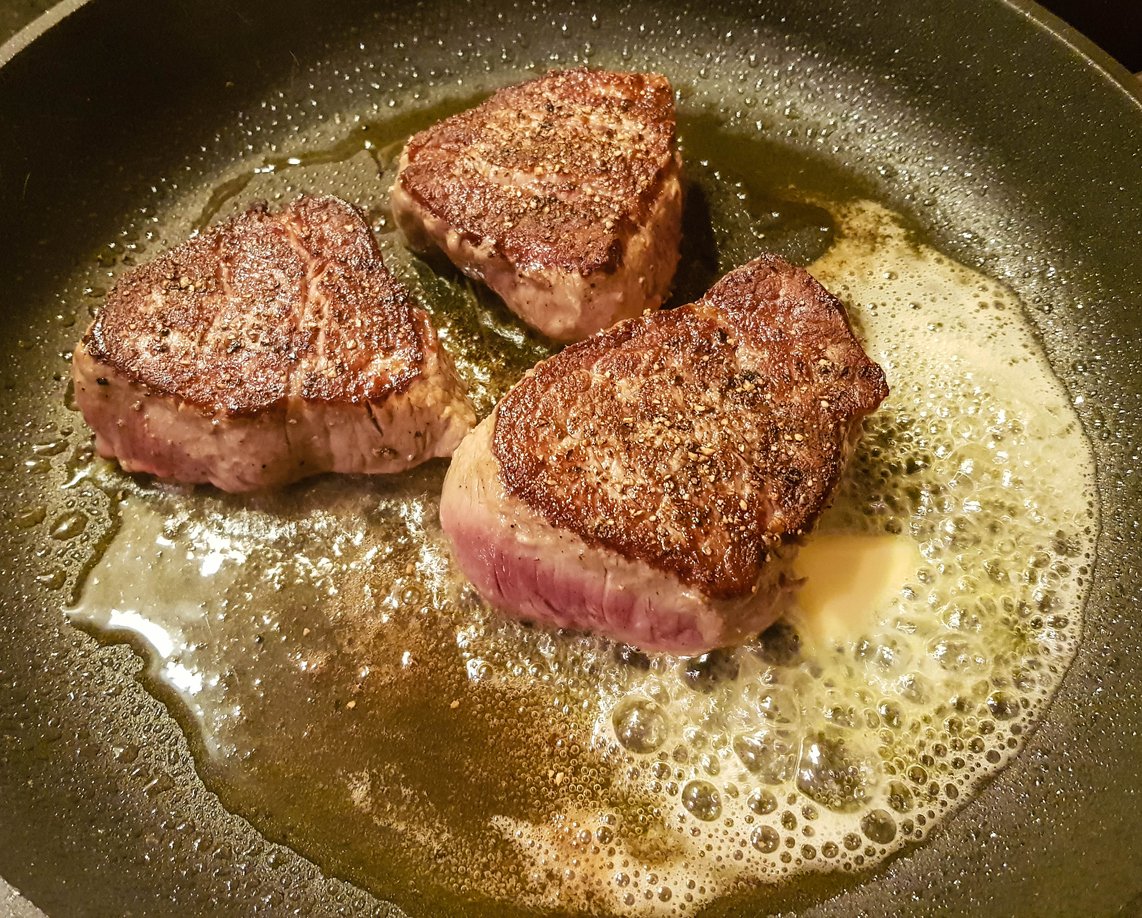Meat Science 103: Understanding your Meats
Discover > Texas Home Cooking > Meat Science 103: Understanding your Meats
Cooking meat in Texas is a reflection of the state’s rich meat industry. In other words, when it comes to beef, poultry, and pork, we Texans know a thing or two. Unfortunately, too often we overlook the role that science plays in how we cook our meat. But not any longer!
For now, let’s take off our chef hats, put on our lab glasses, and look at meat through the eyes of science. This way, we’ll become all the more knowledgeable about how to prepare juicier steaks, safer chicken meat, and beautifully browned pork cutlets.
Cooking Meat: The Meaty Stuff
The first thing to know about meat is that it’s animal muscle. Muscle is made up of around 69–75% water, 18–20% protein, 5–6 % fat, and 1% other substances, such as carbohydrates, salt, vitamins, and minerals.
Each type and cut of meat varies in its composition. For example, pork ribs (What wine goes well with pork ribs?) contain less water than your average piece of meat (65%) but have a much higher fat content (15%). Chicken breast, however, contains far less fat and has a much higher water content, which explains why it shrinks when cooked.
There’s a widespread myth that pricking or stabbing a piece of meat will significantly reduce its size. For instance, the idea that inserting a thermometer into a roast chicken during cooking will somehow ruin it. It's relieving to discover that the notion is utterly erroneous - the water that emerges due to some prodding represents only a minuscule fraction of the meat's total moisture content.
Meat Under the Microscope
Under the microscope, muscle cells look a lot like long pieces of string, which is why they’re called muscle fibers. Bundled muscle fibers are called sheaths, and these sheaths are closely clustered and lumped together.
Each muscle fiber is roughly the size of a human hair and is filled with different kinds of proteins. These include actin and myosin, proteins that bind with water and make the muscles contract.
Location, Location, Location
Have you ever noticed how shoulder and leg cuts are always the toughest? Well, the reason for this is quite simple. The muscles found in these meat products are heavily involved in an animal’s motor function and thus are the largest, thickest, and chewiest. On the other hand, a tenderloin cut – found along the spine of an animal – is soft and tender, as this muscle is worked far less.
Protein plays a large part in muscle function. We’ve learned about myosin and actin, but another important type of protein is myoglobin. Myoglobin is utterly crucial, as it carries oxygen and iron from the hemoglobin to the muscles. Oxygen and iron are fuel for the muscles, allowing them to function properly and efficiently.
Tendons are fibrous tissues that connect muscle and bone. Another kind of connective tissue is the white, shiny sheath that wraps around the muscle, known as silver skin. In the culinary world, this is the tough, elastic part of the meat – a bit like a rubber band – and in many recipes, you’re asked to trim it off. This is because silver skin does not break down during cooking. So it’s important to remove it from a piece of meat, such as tenderloin. If you don’t, the cut may curl up and become dense and chewy.
Just like muscle fibers, connective tissues get thicker and bigger the more they are used. Free-ranging wild boar produce tough meat, as they are always moving and foraging in the wild. Meats full of connective tissues, e.g. ribs or briskets, need to be slow-cooked so that the collagen in them can turn into rich gelatin. This is why these meat products take a particularly long time to cook – well worth it though!
The Importance of Fats in Cooking Meat
A source of plentiful calories, fat is used by the muscles for energy. It surrounds organs such as the kidneys and is responsible for several important bodily functions. Firstly, fats help maintain meat texture, as they prevent muscle fibers from drying up during cooking. Since they don’t evaporate during cooking, they take over the function of water in lubricating muscle fibers. This means juicy pieces of meat, rather than tough, leathery cuts.
The importance of fats in our diet has been subject to a great deal of controversy. Low-fat diet advocates claim that fats are a danger to both individual and public health, as they contain high levels of cholesterol, linked to the development of various heart diseases.
However, recent studies have debunked many of these loaded claims, rebranding them as myths or fallacies. This means that, slowly, fats are being seen in a new light.
Fats bring many benefits to our bodies. They are rich in vitamins and minerals that we need for bodily functions. Fats play several critical roles in our bodies. They serve as a source of energy, contribute to cell growth, protect our organs, and help the body absorb nutrients and produce important hormones. Some fats also aid in maintaining body temperature. However, not all fats are beneficial. Unsaturated fats and Omega-3 fatty acids are considered healthy fats, while Trans fats and saturated fats can be harmful in excess.
Golden Brown and the Maillard Reaction
As you’ve been cooking up a piece of meat, you’re sure to have noticed how the cut turns from a pinkish red to a delicious golden brown. The chemical transformation process at play here is called the Maillard Reaction and occurs when amino acids react with reducing sugars.
The Maillard reaction is named after French scientist Louis-Camille Maillard, a physician who discovered this phenomenon in 1910. In layman’s terms, it simply refers to the browning of the meat’s surface. Not only does it affect the color of the meat, but it also transforms its flavor, bringing a mouthwatering aroma to the cooked product.
Red Meat, White Meat
We talked about myoglobin a little earlier, but there’s a lot more to say about this. Myoglobin is the protein responsible for whether meat is dark or white. It carries oxygen from the hemoglobin to the muscles. As muscles move, they need more oxygen, which is transported by the myoglobin. This means that dark meats, such as chicken thighs (What wine goes well with chicken thighs?), are loaded with oxygen-rich myoglobin.
Chicken thighs are made up of “slow twitch” muscles, which are involved in slow-yet-steady movement. On the other hand, white meats (What wine goes well with white meat?) – e.g. chicken breasts – are subject to brief yet high bursts of energy, and are thus composed of “fast twitch” muscles, which contain less myoglobin.
Dark meat contains more fat and less water than white meat. As a result, when the former is cooked, it doesn’t dry out as the latter does.
The Cooking Process
The heat cooks the meat's surface, but the hot air cannot get past the muscle tissues. How does the inside of a piece of meat get cooked then? Well, the energy from the surface of the meat penetrates the cut, eventually cooking it through all the way.
The cooking process transforms the molecular structures of the fats and proteins, which means the color of the meat changes, a delicious aroma is created, and flavors are stimulated.
During cooking, a certain level of temperature forces structural changes in these fats and proteins. At 95–130°F, animal fats begin to melt, with meat texture transforming at 114°F and above, when muscle fibers start turning into gelatin.
At 120°F, purple-tinted meats start to become red and parasites that are living on the meat begin to be killed off. Once temperatures have reached 130°F, many pathogenic bacteria have died out.
At 130–135°F, meats such as beef are at their most tender, juicy and flavorful – at these temperatures, your steak will be a delicious medium rare.
When temperatures get to 140°F (60°C), a piece of meat starts to become drier. The myoglobin begins to change its structure – what we refer to as “denaturing” – and this pink-colored protein rises to the surface of the meat. This isn’t blood, just a combination of protein and water.
Meats, especially chicken meat, are at their safest once they have reached an internal temperature of 160–165°F (71-74°C). At these temperatures, most microbes and pathogens inside and outside the meat have been eradicated.
The best way to determine the temperature of your meat is to use a thermometer. And if you can get your hands on one, an instant-read digital thermometer is by far the best.
Understanding Meat Cuts
Meat Cuts can be a complex process, but it becomes easier when you know what to look for. For instance, if you're looking for a tender cut, consider the flat iron steak from the cow's shoulder, or the ribeye steak (What wine goes well with ribeye steak?) from the cow's ribs.
Flank steak and porterhouse steak are also tender cuts, but they come from different parts of the cow. If you prefer a leaner option, ground beef is versatile and can be used in a variety of dishes. For those interested in animal raising claims, this term refers to how the cow was raised, which can affect the quality and taste of the meat.
When it comes to cuts that are perfect for slow cooking, the chuck pot roast, beef short ribs, (What wine goes well with beef short ribs?) and chuck short ribs are all excellent choices. If you're looking for something different, you might want to try corned beef or stew meat. And don't forget about the shoulder tender medallions and country-style ribs — these cuts are perfect for grilling or broiling.
When it comes to a flavorful, hearty meal, the beef short ribs are a standout choice. They're incredibly rich and delicious when slow-cooked to perfection. For those who prefer a classic steak experience, rib steak offers a balance of tenderness and robust beef flavor.
Meanwhile, for health-conscious eaters, the category of lean meat such as flank steak or round steak can offer less fatty, but equally satisfying options. Lastly, if you're looking to splurge on a special occasion, the Porterhouse steaks are a luxurious option.
How to Tell If Meat is Bad After Cooking?
You can usually tell if meat has gone bad after cooking by its smell - if it has a terrible odor, it's probably spoiled. But that's not the only way to spot bad meat. Other signs to look out for are its color and texture; if it appears to have mold, it should be discarded.
Searching online for "fresh meat market near me" is a useful way to locate the top stores for purchasing fresh meat. However, being well-versed in the science of meat is also essential for improving your kitchen practices. Gaining a scientific insight into the meat can enhance your cooking skills, making you a better, and crucially, safer cook. For more insights into BBQ techniques, do check out the Ultimate Texas BBQ Guide.






